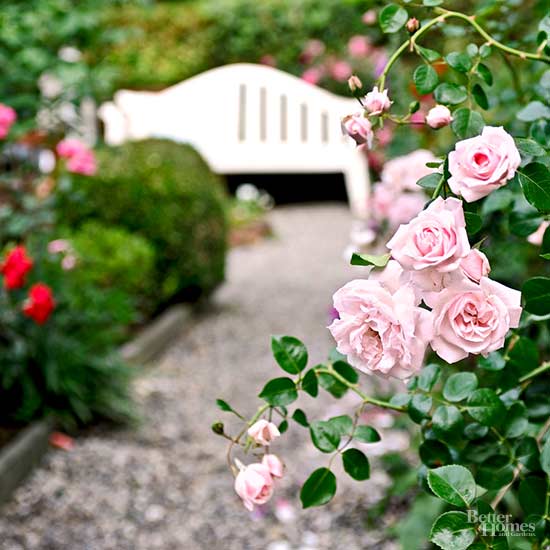






It's surprising how many people think that roses, perhaps because of their beauty, must be hard to grow. But roses are tough! You basically need two things to grow roses: sun and water.
Sun: Roses flower best when they get at least six hours of sunlight per day, preferably more. Some roses bloom in partial shade but do much better in full sun.
Water: Roses thrive with at least 1 inch of water per week. But they hate waterlogged roots and can develop leaf diseases if they're watered from an overhead sprinkler system. Plant them in soil that drains easily. Use a soaker hose or lay a hose end next to the roots, and water with a slow drizzle for half an hour.
Check out our ultimate rose care guide.
It's best to plant roses in the fall or spring, giving them time to stretch out and grow new roots before it's time to bloom.
Dig a hole about 2 feet wide and 1 foot deep, amending the soil with compost. Chemical fertilizer can burn the new roots, so avoid adding it at planting time.
Learn how to compost.
If you are planting a container rose, place the pot on the ground and gently press the sides of the container to ease the plant out instead of gripping it from the top. Position the bud union (where the canes meet the roots) about 2 to 3 inches below the soil line if you are in a northern cold climate and just above the soil line if you are in a warm climate.
For boxed roses, follow the same guidelines as for container roses. Remove the box or peat pot before planting. Even if the tag says the pot is biodegradable, it may not decompose fast enough, thus inhibiting growth.
When planting bare-root roses, clip 1/2 inch off the tips of the largest roots, which will stimulate new growth. If the canes are taller than 4 to 8 inches, clip those, too. Then form a small cone of soil in the bottom of your hole, and place the roots on top. As with other roses, place the bud union (where the canes meet the roots) about 2 to 3 inches below the soil line if you are in a northern cold climate and just above the soil line if you are in a warm climate.
Fill in the remainder of the hole with the soil you removed, and water well.
A 2- to 4-inch layer of organic mulch around your rose bush, such as pine needles, compost, shredded bark, or hardwood chips, can help retain moisture and suppress weeds.
Always allow plenty of space around roses so they get enough air circulation to head off disease and insect problems. Check the plant tag to see the recommended space.
Rose bush care can be as easy or complicated as you wish, and may vary with the type of rose you choose. Shrub roses are among the easiest to grow and need little maintenance. Hybrid teas need more attention.
Learn more about the easiest roses.
Fertilizer may be applied in spring and early summer to promote plant and flower growth. You can choose from organic or synthetic fertilizers. A fertilizer branded specifically for roses isn't necessary; a balanced-formula (10-10-10 or 20-20-20) fertilizer is fine. A slow-release fertilizer applied once in a growing season is often enough.
Rose rosette disease, a devastating virus spreading quickly in many parts of the country, is the biggest threat to growing roses. Once a plant is infected, there is no cure. Remove the entire plant, including all the roots. Burn or bag and confine the plant; never add it to a compost pile.
Symptoms of rose rosette disease include clusters of new growth on existing canes called "witch's broom," new and thicker canes with excessive thorniness, or extra red coloration in the new tip growth. However, new growth on some roses is naturally red. Other pests, stresses, or diseases can cause problems that may resemble rose rosette disease. Look for other symptoms of rose rosette disease before you dig up your plants.
There are a host of pests that adore roses, including Japanese beetles, cane borers, and aphids. To save money and garden more organically, it's best to begin with disease-resistant rose varieties, avoid crowding plants, keep roses pruned to open up the center to air and sunlight, and avoid overhead watering.
Learn how to protect your roses from black spot.
Copyright © www.100flowers.win Botanic Garden All Rights Reserved